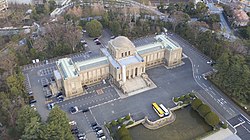| Meiji Memorial Picture Gallery | |
|---|---|
聖徳記念絵画館 | |
 Aerial view of the gallery | |
 | |
| General information | |
| Address | 1-1 Kasumigaoka-machi |
| Town or city | Shinjuku, Tōkyō |
| Country | Japan |
| Coordinates | 35°40′44″N 139°43′04″E / 35.678778°N 139.717639°E |
| Construction started | 3 October 1919[1] |
| Completed | 22 October 1926[2] |
| Opened | 23 October 1926[1] |
| Technical details | |
| Floor count | Single storey, plus basement[3] |
| Floor area | 2,348.52 square metres (25,279.3 sq ft)[3] |
| Design and construction | |
| Architect(s) | Kobayashi Masatsugu (design amended by Meiji Jingū Construction Bureau (明治神宮造営局))[2] |
| Main contractor | Ōkura Doboku (大倉土木) (now Taisei Corporation)[4] |
| Website | |
| Official website | |
Meiji Memorial Picture Gallery (聖徳記念絵画館, Seitoku Kinen Kaigakan) is a gallery commemorating the "imperial virtues" of Japan's Meiji Emperor, installed on his funeral site in the Gaien or outer precinct of Meiji Shrine in Tōkyō. The gallery is one of the earliest museum buildings in Japan and itself an Important Cultural Property.
On display in the gallery are eighty large paintings, forty in "Japanese style" (Nihonga) and forty in "Western style" (Yōga), that depict, in chronological order, scenes from the Emperor's life and times. The gallery opened to the public in 1926, with the final paintings completed and installed ten years later. The selection and investigation of suitable topics for the paintings was overseen by Kaneko Kentarō, who also served as head of the editorial boards of Dai-Nihon Ishin Shiryō and Meiji Tennōki, major contemporary historiographic undertakings respectively to document the Meiji Restoration (in 4,215 volumes) and the Meiji Emperor and his era (in 260 volumes);[5] as such, the gallery and its paintings may be viewed as a highly-visible historiographic project in its own right.[5][6]
- ^ a b 聖徳記念絵画館とは [About the Meiji Memorial Picture Gallery] (in Japanese). Meiji Jingū Gaien. Retrieved 1 September 2020.
- ^ a b 聖徳記念絵画館 [Meiji Memorial Picture Gallery] (in Japanese). Meiji Jingū Gaien. Retrieved 31 August 2020.
- ^ a b Cite error: The named reference
ICPwas invoked but never defined (see the help page). - ^ 2008年度ご報告 [2008 Annual Report] (PDF). Taisei Corporation. p. 12. Retrieved 1 September 2020.
- ^ a b Imaizumi Yoshiko (2011). "The Making of a Mnemonic Space: Meiji Shrine Memorial Art Gallery 1912–1936". Japan Review. 23. International Research Center for Japanese Studies: 143–176.
- ^ Meiji Jingū Gaien, ed. (2001). 聖徳記念絵画館壁画 [Explanatory Notes on pictures in Memorial Picture Gallery, Meiji Jingū] (in Japanese).